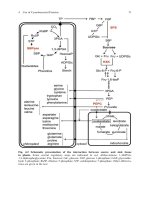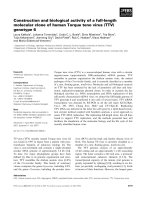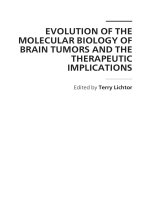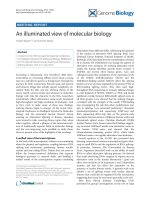Springer molecular biology of human cancers an advanced students textbook (2005) YYePG lotb
Bạn đang xem bản rút gọn của tài liệu. Xem và tải ngay bản đầy đủ của tài liệu tại đây (12.6 MB, 529 trang )
PART I
MOLECULES, MECHANISMS, AND CELLS
This page intentionally left blank
MOLECULAR BIOLOGY OF HUMAN CANCERS
This page intentionally left blank
Molecular Biology of Human
Cancers
An Advanced Student’s Textbook
by
WOLFGANG ARTHUR SCHULZ
Department of Urology and Center for Biological and Medical Research,
Heinrich Heine University, Dusseldorf, Germany
Springer
eBook ISBN:
Print ISBN:
1-4020-3186-6
1-4020-3185-8
©2005 Springer Science + Business Media, Inc.
Print ©2005 Springer
Dordrecht
All rights reserved
No part of this eBook may be reproduced or transmitted in any form or by any means, electronic,
mechanical, recording, or otherwise, without written consent from the Publisher
Created in the United States of America
Visit Springer's eBookstore at:
and the Springer Global Website Online at:
meinen Eltern gewidmet
This page intentionally left blank
TABLE OF CONTENTS
Preface: How to read this book………………………………………………... xiii
Acknowledgements ……………………………………………………………. xvii
PART I – MOLECULES, MECHANISMS, AND CELLS
1 An Introduction to Human Cancers..................................................................... 1
1.1 An overview of the cancer problem .................................................................. 1
1.2 Causes of cancer............................................................................................... 5
Box 1.1 Reactive oxygen species ........................................................................ 10
1.3 Characteristic Properties of Cancers and Cancer Cells................................ 11
Box 1.2: Hallmarks of Cancer ............................................................................. 18
1.4 Characterization and Classification of Cancers in the Clinic ....................... 17
1.5 Treatment of Cancer ....................................................................................... 21
Further reading..................................................................................................... 23
2 Tumor Genetics .................................................................................................... 25
2.1 Cancer as a genetic disease............................................................................ 26
2.2. Genetic alterations in cancer cells ................................................................ 27
2.3 Inherited predisposition to cancer.................................................................. 37
2.4 Cancer genes .................................................................................................. 42
2.5 Accumulation of genetic and epigenetic changes in human cancers ............. 44
Further reading..................................................................................................... 45
Box 2.1 Tumor viruses in human cancers ........................................................... 46
3 DNA Damage and DNA Repair .......................................................................... 47
3.1 DNA damage during replication: base excision and nucleotide excision
repair.............................................................................................................. 48
3.2 Nucleotide excision repair and crosslink repair ............................................ 55
3.3 Strand-break repair ........................................................................................ 62
3.4 Defects in DNA repair and cancer susceptibility ........................................... 66
3.5 Cell protection mechanisms in cancer............................................................ 68
Further reading..................................................................................................... 70
4 Oncogenes.............................................................................................................. 71
4.1 Retroviral oncogenes ...................................................................................... 72
4.2 Slow-acting transforming retroviruses........................................................... 75
4.3 Approaches to the identification of human oncogenes................................... 78
4.4 Functions of human oncogenes ...................................................................... 84
Further reading..................................................................................................... 89
Box 4.1 Carcinogenesis by HTLV-I.................................................................... 90
5 Tumor Suppressor Genes .................................................................................... 91
5.1 Tumor suppressor genes in hereditary cancers.............................................. 92
5.2 RB1 and the cell cycle..................................................................................... 97
5.3 TP53 as a different kind of tumor suppressor .............................................. 101
vii
viii
5.4 Classification of tumor suppressor genes..................................................... 109
Further reading................................................................................................... 111
Box 5.1 Human papilloma viruses..................................................................... 112
6 Cancer Pathways ................................................................................................ 113
6.1 Cancer Pathways .......................................................................................... 114
6.2 MAPK signaling as a cancer pathway ......................................................... 115
6.3 The PI3K pathway ........................................................................................ 119
6.4 Regulation of the cell cycle by the MAPK and PI3K pathways ................... 123
6.5 Modulators of the MAPK and PI3K pathways ............................................. 126
6.6 The TP53 network......................................................................................... 129
6.7 Signaling by TGF
FE factors .......................................................................... 131
6.8 Signaling through STAT factors ................................................................... 132
6.9 The NF
FNB pathway ....................................................................................... 135
6.10 Developmental regulatory systems as cancer pathways ............................ 137
Further reading................................................................................................... 144
7 Apoptosis and Replicative Senescence in Cancer............................................ 145
7.1 Limits to cell proliferation ............................................................................ 146
7.2 Mechanisms of apoptosis.............................................................................. 150
7.3 Mechanisms of diminished apoptosis in cancer ........................................... 156
7.4 Replicative senescence and its disturbances in human cancers................... 159
Further reading................................................................................................... 164
Box 7.1: Human aging and cancer..................................................................... 165
8 Cancer Epigenetics ............................................................................................. 167
8.1 Mechanisms of epigenetic inheritance ......................................................... 168
8.2 Imprinting and X-inactivation ...................................................................... 170
8.3 DNA methylation .......................................................................................... 174
8.4 Chromatin structure...................................................................................... 179
8.5 Epigenetics of cell differentiation................................................................. 182
8.6 Epigenetics of tissue homeostasis................................................................. 185
Further reading................................................................................................... 191
Box 8.1 Carcinogenesis by HIV
192
9 Invasion and metastasis ..................................................................................... 193
9.1 Invasion and metastasis as multistep processes........................................... 194
9.2 Genes and proteins involved in cell-to-cell and cell-matrix adhesion......... 197
9.3 Genes and proteins involved in extracellular matrix remodeling
during tumor invasion ................................................................................. 202
9.4 Angiogenesis ................................................................................................. 206
9.5 Interactions of invasive tumors with the immune system ............................. 210
9.6 The importance of tumor-stroma interactions.............................................. 212
Further reading................................................................................................... 216
Box 9.1 Tumor hypoxia and its consequences .................................................. 217
ix
PART II - HUMAN CANCERS
10 Leukemias and Lymphomas............................................................................ 219
10.1 Common properties of hematological cancers........................................... 221
10.2 Genetic aberrations in leukemias and lymphomas..................................... 223
10.3 Molecular biology of Burkitt lymphoma..................................................... 226
10.4 Molecular biology of CML ......................................................................... 232
10.5 Molecular biology of PML ......................................................................... 237
Further reading................................................................................................... 242
11 Wilms Tumor (nephroblastoma) .................................................................... 243
11.1 Histology, etiology and clinical behavior of Wilms tumors ....................... 244
11.2 Genetics of Wilms tumors and the WT1 gene............................................. 246
11.3 Epigenetics of Wilms tumors and the ‘WT2’ locus..................................... 250
11.4 Towards an improved classification of Wilms tumors ............................... 252
Further reading................................................................................................... 253
12 Cancers of the skin ........................................................................................... 255
12.1 Carcinogenesis in the skin .......................................................................... 256
12.2 Squamous cell carcinoma ........................................................................... 260
12.3 Basal Cell Carcinoma................................................................................. 262
12.4 Melanoma ................................................................................................... 266
12.5 Tumor antigens ........................................................................................... 269
Further reading................................................................................................... 270
13 Colon Cancer .................................................................................................... 271
13. 1 Natural history of colorectal cancer ......................................................... 272
13.2 Familial Adenomatous Polyposis Coli and the WNT pathway .................. 273
13.3 Progression of Colon Cancer and the Multi-Step Model
of Tumorigenesis .......................................................................................... 280
13.4 Hereditary nonpolyposis colon carcinoma ................................................ 282
13.5 Genomic instability in colon carcinoma..................................................... 284
13.6 Inflammation and colon cancer.................................................................. 285
Further reading................................................................................................... 287
Box 13.1 Positional cloning of tumor suppressor genes in hereditary cancers . 288
14 Bladder Cancer ................................................................................................. 289
14.1 Histology and etiology of bladder cancer .................................................. 290
14.2 Molecular alterations in invasive bladder cancers .................................... 297
14.3 Molecular alterations in papillary bladder cancers .................................. 302
14.4 A comparison of bladder cancer subtypes.................................................. 304
Further reading................................................................................................... 305
Box 14.1: Tumor suppressor candidates at 9q in bladder cancer ...................... 306
15 Renal Cell Carcinoma ...................................................................................... 307
15.1 The diversity of renal cancers .................................................................... 308
15.2 Cytogenetics of renal cell carcinomas........................................................ 310
x
15.3 Molecular biology of inherited kidney cancers .......................................... 311
15.4 Von-Hippel-Lindau syndrome and renal carcinoma.................................. 316
15.5 Molecular biology of clear cell renal carcinoma....................................... 321
15.6 Chemotherapy and immunotherapy of renal carcinomas .......................... 324
Further reading................................................................................................... 326
16 Liver Cancer ..................................................................................................... 327
16.1 Etiology of liver cancer .............................................................................. 328
16.2 Genetic changes in hepatocellular carcinoma ........................................... 331
16.3 Viruses in HCC ........................................................................................... 336
Further reading................................................................................................... 339
Box 16.1 Hepatocellular carcinoma in experimental animals........................... 340
17 Stomach Cancer................................................................................................ 341
17.1 Etiology of stomach cancer ........................................................................ 342
17.2 Molecular mechanisms in gastric cancer................................................... 345
17.3 Helicobacter pylori and stomach cancer.................................................... 348
Further reading................................................................................................... 354
Box 17.1: Barrett esophagus and esophageal cancer......................................... 355
18 Breast Cancer.................................................................................................... 357
18.1 Breast biology............................................................................................. 358
18.2 Etiology of breast cancer............................................................................ 364
18.3 Hereditary breast cancer............................................................................ 365
18.4 Estrogen receptors and ERBB proteins in breast cancer........................... 373
18.5 Classification of breast cancers ................................................................. 378
Further reading:.................................................................................................. 382
19 Prostate Cancer ................................................................................................ 383
19.1 Epidemiology of prostate cancer................................................................ 384
19.2 Androgens in prostate cancer..................................................................... 389
19.3 Genetics and epigenetics of prostate cancer .............................................. 394
19.4 Tumor-stroma interactions in prostate cancer........................................... 398
Further reading................................................................................................... 402
PART III - PREVENTION, DIAGNOSIS, AND THERAPY
20 Cancer Prevention ............................................................................................ 403
20.1 The importance of cancer prevention......................................................... 403
20.2 Primary prevention..................................................................................... 404
20.3 Cancer prevention and diet ........................................................................ 408
20.4 Prevention of cancers in groups at high risk.............................................. 415
20.5 Prevention of prostate cancer by screening the aging male population.... 420
20.6 Other types of prevention ........................................................................... 423
Further reading................................................................................................... 426
xi
21 Cancer Diagnosis .............................................................................................. 427
21.1 The evolving scope of molecular diagnostics ............................................. 427
21.2 Molecular diagnosis of hematological cancers.......................................... 429
21.3 Molecular detection of carcinomas ............................................................ 433
21.4 Molecular classification of carcinomas ..................................................... 439
21.5 Prospects of molecular diagnostics in the age of individualized therapy.. 442
Further reading................................................................................................... 447
22 Cancer Therapy ................................................................................................ 449
22.1 Limitations of current cancer therapies ..................................................... 449
22.2 Molecular mechanisms of cancer chemotherapy ....................................... 450
22.3 Principles of targeted drug therapy............................................................ 459
22.4 Examples of new target-directed drug therapies........................................ 464
22.5 New concepts in cancer therapy: Immunotherapy ..................................... 475
22.6 New concepts in cancer therapy: Gene therapy......................................... 479
22.7 The future of cancer therapy ...................................................................... 486
KEYWORD INDEX .............................................................................................489
This page intentionally left blank
PREFACE: HOW TO READ THIS BOOK
The present book grew out from a lecture course I have taught for more than 5 years,
often together with colleagues who covered topics and cancers they are more
familiar with than myself. These lectures were mainly attended by biology and
medical students well advanced in their curricula, but also by clinical trainees doing
cancer research in the lab, and by graduate students and postdocs having entered
cancer research from different fields, including chemistry, pharmacology,
developmental genetics, physics, and even mathematics. This experience reflects
how cancer research, cancer prevention, and even cancer treatment increasingly
become interdisciplinary efforts.
While writing the book I had this motley group of people in mind, figuring that
they all, with their different backgrounds, could make use of an introduction to the
molecular biology of human cancers. Specifically, I felt that a textbook for more
advanced students was required to fill a gap between standard textbooks on one
hand and specialized reviews or even original research papers on the other hand.
Moreover, the textbooks on molecular biology and genetics are usually read by
biologists and those on pathology and clinical oncology only by medical students.
Accordingly, for biologists and chemists medical terms had to be introduced, and for
the readers from the medical profession some general molecular biology had to be
explained. So, please do not scoff if some statements in this book are found on the
first five pages of the standard textbook in your specialty. However, this is neither a
book on biochemical mechanisms nor on clinical oncology. So, if you do not
understand medical terms or molecular issues in the book, please borrow a textbook
from a student of the other discipline or (better…) ask them to explain.
The book is intended to provide a relatively short overview of important
concepts and notions on the molecular biology of human cancers (according to the
author’s opinion), including many facts essential to find one’s way in this field. It is,
however, not meant to be comprehensive and probably cannot be, as our knowledge
is rapidly growing. A list of other textbooks and handbooks can be found in the
‘further reading’ section of Chapter 1.
This book is named ‘Molecular Biology of Human Cancers’ because molecular
biology is at its center, although in some places I have attempted to put this specific
angle of approach to the cancer problem into a broader, ‘real world’ perspective,
particularly in Part III. ‘Human’ is supposed to stress that cancers in humans and not
in other organisms or in vitro models of cancer are the main issue (most evidently in
the central Part II). The plural ‘Cancers’ is to indicate that the diversity of human
cancers is stressed, although common mechanisms are treated in depth.
The subtitle is also programmatic. It reads ‘An Advanced Student’s Textbook’
most of all because the book is supposed to bridge the gap from undergraduate
textbooks to the specialized literature. This is only one of several reasons for putting
‘Advanced’ in the subtitle. Advanced students also understand that knowledge is
evolving and must be constantly questioned. So I have not avoided to point out the
limits of current knowledge and open questions, as they appear to me. Advanced
xiii
xiv
students have learned that scientific questions are pursued in a real world, which
imposes limits on what we understand about human cancers and what we can do
about them. I have therefore not avoided to mention limits of that sort either, where
appropriate. Advanced students also know how to find literature on a subject, if they
want to check statements in the book. For that reason and to limit the size of the
volume, I have restricted the references to suggestions for further reading, which
follow each chapter. Most references are review articles, and almost all are in
English.
I have tried to keep the book to a size that can be read in a couple of weeks (one
or two chapters per day) and to write in a style that is not so dry as to make reading a
trial in endurance. Hopefully, you will not find it too journalistic. Ideally, you would
read the volume from start to finish. If you do so, you will notice that many
important facts and ideas appear in several places, often described from different
angles. This redundancy is intended to help memorize important issues and link
facts and concepts to each other. If you find essential points missing, please follow
my request in the last paragraph of this preface.
A second reading strategy is to follow the many cross-references in the book and
‘surf’ it. This approach is strongly recommended to casual readers and also to those
who are already familiar with cancer molecular biology. To help you scan the book
and find out what interests you, all chapters (except the first introductory one and
the three more essay-style chapters in Part III) contain a short introductory section
listing their essential points. Each chapter then proceeds to a more detailed
exposition, but also contains additional points that are too specialized (or too
speculative) to be of interest to every reader. So, you could browse this book by
reading the one or two introductory pages of each chapter and if you think ’I know
all this’ move on to the next one. Some issues which did not fit well into the general
stream of thought are placed in separate boxes. Be aware that these are treated in a
particularly cursory fashion.
Part I starts with a brief overview chapter, which serves mainly to define terms
and introduce concepts and issues that are treated in more depth and detail in later
chapters. The following chapters deal with molecules and mechanisms important in
human cancers. Although these chapters contain a lot of information, they present
only a fraction of what is known in this regard, since knowledge on individual
molecules and their interactions is presently expanding at a particularly rapid pace.
For instance, |250 genes are now considered oncogenes or tumor suppressor genes
in humans, by a strict definition, and at least ten times as many are implicated as
important in cancer biology. Some molecules and many mechanisms are common to
several human cancers, but the actual mechanisms for each type or even subtype of
cancer differ. One could picture this relationship as a large set of oncogenic
mechanisms, from which various subsets are relevant in different cancers.
In some cancers, the mechanisms involved in carcinogenesis, cancer progression,
or response to therapy are rather well understood, and the role of specific genes and
proteins has been well elucidated. In my opinion, the most exciting and promising
development in cancer research is an increasing ability to not only identify and list
molecular changes, but also to relate them to the characteristic biological properties
xv
and clinical behavior of specific human cancers. The cancers discussed in Part II are
selected according to this criterion. They are therefore not necessarily the most
prevalent or lethal cancers, although many of these are treated. Accordingly, the
treatment of each cancer type is not comprehensive either, but focuses on those
selected issues and mechanisms that we understand best.
Application of the knowledge presented in Part I and Part II has begun to
improve the prevention, diagnosis, and therapy of human cancers. Part III therefore
gives a short sketch of the progress, problems, and possible future of the
developments in these areas. Clearly, there is a still a long way to go until the
insights from molecular biological research are fully translated into a benefit for
fellow humans. Hopefully, this part will have to be much longer in future books.
Finally, I have a request to the readers. I have tried, with the help of my
colleagues acknowledged in the following acknowledgement section to keep this
book as free of mistakes as possible, to deal with the most important issues in cancer
molecular biology and to label opinions and speculations as such, but certainly many
errors remain. Please, send a short note on any that you find, best by e-mail
(), I have asked for an extra-large size mailbox
on our university server.
This page intentionally left blank
ACKNOWLEDGEMENTS
Many colleagues from our university have contributed figures and references for
the book. They are usually acknowledged in the figure legends. I am particularly
grateful to Prof. Claus-Dieter Gerharz for most of the histology figures, to Dr. Georg
Kronenwett for expert advice on hematological cancers, and to Dr. Andrea
Linnemann-Florl for drawing many figures and improving many of my own. I am
further obliged to them and several other colleagues for reading and commenting on
individual chapters or large parts of the book, specifically Dr. Aristoteles
Anastasiadis, Dr. Sylvia Geisel, Michèle Hoffmann, Prof. Joseph Locker, Prof.
Stephan Ludwig, Dr. Dieter Niederacher, Dr. Julia Reifenberger, Dr. Ingo Schmitz,
Dr. Valerie Schumacher, and Dr. Hans-Helge Seifert. Ms. Bettina Möller has kindly
helped with the formatting and editing of the final version and Ms. Olga Schulz with
the index.
I have to apologize to my co-workers in the lab, Andrea Linnemann–Florl,
Michèle Hoffmann, Christiane Hader, Andrea Prior, and Marc Cronauer, for not
giving them my full attention for more than a year and even more to our lab students
and trainees during that period. I am very grateful to all of them for compensating
through their own initiative. I am also grateful to our head of department, Prof.
Ackermann, for supporting the endeavor.
At Kluwer press (now Springer), Ebru Umar talked me into writing the book,
and later Christina dos Santos and Melania Ruiz took care of the project.
If I ever did wonder why book authors feel obliged to thank their families for
support, I now know. So, thank you, Geli, Olga, and Edwin!
Düsseldorf, September 2004
WAS
xvii
This page intentionally left blank
CHAPTER 1
AN INTRODUCTION TO HUMAN CANCERS
1.1 AN OVERVIEW OF THE CANCER PROBLEM
What is commonly called ‘human cancer’ comprises in fact more than 200 different
diseases. Together, they account for about one fifth of all deaths in the industrialized
countries of the Western World. Likewise, one person out of three will be treated for
a severe cancer in their life-time. In a typical Western industrialized country like
Germany with its 82 million inhabitants, >400,000 persons are newly diagnosed
with cancer each year, and |200,000 succumb to the disease. Since the incidence of
most cancers increases with age, these figures are going to rise, if life expectancy
continues to increase.
If one considers the incidence and mortality by organ site, while ignoring further
biological and clinical differences, cancers fall into three large groups (Figure 1.1).
Cancers arising from epithelia are called ‘carcinomas’. These are the most prevalent
cancers overall. Four carcinomas are particular important with regard to incidence as
well as mortality. Cancers of the lung and the large intestine (colon and rectum,
o13) are the most significant problem in both genders, together with breast cancer
(o18) in women and prostate cancer (o19) in men. A second group of cancers are
not quite as prevalent as these ‘major four’ cancers. They comprise carcinomas of
the bladder (o14), stomach (o17), liver (o16), kidney (o15), pancreas,
esophagus, and of the cervix and ovary in women. Each accounts for a few percent
of the total cancer incidence and mortality. Each of them is roughly as frequent as all
leukemias or lymphomas (o10) taken together. The most prevalent cancers are
those of the skin (o12), not shown in figure 1.1. They are rarely lethal, with the
important exception of melanoma. Cancers of soft tissues, brain, testes, bone, and
other organs are relatively rare; but can constitute a significant health problem in
specific age groups and geographic regions. For instance, testicular cancer is
generally the most frequent neoplasia affecting young adult males, with an incidence
of >1% in this group in some Scandinavian countries and in Switzerland.
The health situation in less-industrialized countries differs principally from that
in the highly industrialized part of the world because of the continuing, recurring or
newly emerged threat of infectious diseases, which include malaria, tuberculosis,
and AIDS. Nevertheless, cancer is important in these countries as well, with
different patterns of incidence and often higher mortalities. Cancers of the stomach
(o17), liver (o16), bladder (o14), esophagus, and the cervix are each endemic in
certain parts of the world (Figure 1.2). Often, they manifest at younger ages than in
industrialized countries. Conversely, of the major four cancers in industrialized
countries, only lung cancer has the same impact in developing countries.
1
2
CHAPTER 1
Figure 1.1 Incidence (top) and mortality (bottom) of cancers (cases per year) by organ
site for females (grey bars) and males (black bars) in Germany in 2000.
Data are from the Robert Koch Institute (www.rki.de).
This snapshot view of present-day cancer incidence of course conceals changes
over time (Figure 1.3). For instance, large-scale industrialization and the spread of
cigarette smoking are generally associated with an increased incidence of lung,
kidney, and bladder cancer. On the positive side, improvements in general hygiene
and food quality may have contributed to the spectacular decrease in stomach cancer
AN INTRODUCTION TO HUMAN CANCERS
3
incidence that is continuing in industrialized countries (o17.1). On the negative
side, prostate and testicular cancer appear to have increased over the last decades. In
prostate cancer, a slight increase in the age-adjusted incidence is exacerbated by the
overall aging of the population (o19.1).In some regions, the incidence of melanoma
has escalated in an alarming fashion. This increase is not related to the aging of the
population, but perhaps to life-style factors (o12.1).
One important aim of molecular biology research on human cancers is to
understand the causes underlying the geographical and temporal differences in
cancer incidence. This understanding is one important prerequisite for cancer
prevention (o20). Obviously, the prospects for prevention are brightest for those
cancers that exhibit large geographical differences or the great changes over time in
their incidences. To give just one example: The incidence of prostate cancer of East
Asia residents may be 10-20-fold lower than that of their relatives who grow up in
the USA (o19.1). It is easy imagining the potential for prevention, if the causes for
this difference were understood.
Unfortunately, overall, neither incidence nor mortality of human cancer have
been much diminished by conscious human intervention over the last decades. The
mainstay of treatment of the ‘big four’ cancers and of the carcinomas in the second
group outlined above remain surgery, radiotherapy, and chemotherapy, as they were
30 years ago. Surgery and radiotherapy are often successful in organ-confined cases,
and chemotherapy is moderately efficacious for some advanced cancers. In general,
only modest improvements have been made in cure and survival rates for these.
Importantly, the quality of life for the patients is now widely accepted as a criterion
Figure 1.2 Mortality of selected cancers by organ site in different regions of the World
In each group of bars from left to right: World average, Africa, North-America, SouthAmerica, North-West Europe, China. Data source: Shibaya et al, BMC Cancer 2, 37ff
4
CHAPTER 1
for successful therapy. Modern cancer therapy recognizes that not every malignant
tumor can be cured by the means presently available. So, treatment needs to be
carefully chosen to maximize the chance for a cure while retaining a maximum of
life quality. Providing a better basis for this choice will perhaps constitute the most
immediate application of new insights on the molecular biology of cancers (o21).
In addition, palliative treatments have become more sophisticated and pain
medications are less restrictively administered. Nevertheless, the treatment of
metastatic carcinomas remains the weakest point of current cancer therapy and a
crucial goal of cancer research (o22).
Figure 1.3 Trends in the mortality of selected cancers in the USA
The original data figure is from the American Cancer Society.
Great steps towards successful treatment have been made with specific cancers,
unfortunately mostly from the third group above. These improvement have had little
effect on the impact of cancer on the overall population, but have helped many
individuals, often young people and children. Formerly incurable leukemias and
lymphomas can now be successfully treated by chemotherapy and/or stem cell
transplantation, particularly in children and young adults. Likewise, the rise in
testicular cancer incidence is stemmed by highly efficacious chemo- and
radiotherapy, with cure rates exceeding 90%. Obviously, there is a need to
understand why these cancers, but not others respond so well to the
chemotherapeutic drugs currently available. It is hoped that a better understanding of
the molecular and cellular basis underlying this difference will eventually open the
door to successful treatment of the major carcinomas, as will the development of
novel drugs and novel therapies based on the results of molecular biological cancer
research (o22).









